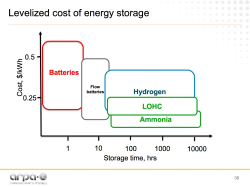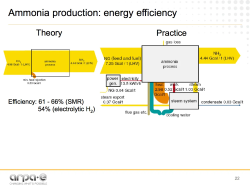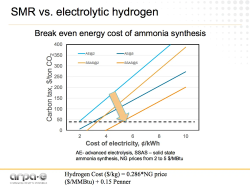ARPA-E’s “transformative” ammonia synthesis technologies
By Trevor Brown on October 28, 2016
The US Department of Energy’s Advanced Research Project Agency (ARPA-E) is funding projects with a view to commercializing low- and zero-carbon ammonia synthesis technologies.
Grigorii Soloveichik, ARPA-E Program Director, described the aims and challenges of his agency’s initiative and introduced the technologies currently in development in his keynote presentation at the recent NH3 Fuel Conference, in September 2016.
ARPA-E’s interest is fundamentally different from the interest of the fertilizer industry.
As a fertilizer, the value of ammonia (NH3) is in its nitrogen content, because “fixed” nitrogen (N) is biologically available as a plant nutrient, whereas atmospheric nitrogen (N2) is not.
ARPA-E’s mission is to develop energy technologies, not plant nutrients, and it views ammonia as both a carbon-free regenerable liquid fuel and an efficient medium for hydrogen storage and distribution.
As an “energy vector,” therefore, the value of ammonia is in its hydrogen content – the nitrogen is more or less irrelevant. If the nitrogen content of ammonia is 82.2% by weight, its hydrogen content is 17.8%.
This 17.8% hydrogen content means that ammonia – which has safely and effectively been used as a fuel in many niche and one-off applications since the 1930s (the X-15 rocket plane broke air speed and altitude records using ammonia fuel in the 1950s and ’60s) – has an energy density of 4.32 kWh per liter.
This energy density is similar to methanol and almost twice that of liquid hydrogen. To a certain extent, energy density explains the challenge with using hydrogen as a fuel: it is extremely difficult to manage the super-low temperatures or high-pressures necessary to make hydrogen sufficiently energy-dense.
This is why ammonia is often called “the other hydrogen” – there is more hydrogen in ammonia than there is in hydrogen, volumetrically speaking.

Levelized Cost of Energy Storage, Grigorii Soloveichik, NH3 Fuel Conference, 09/19/2016
To give a simple demonstration of the energy value of ammonia, Soloveichik presented a chart of the Levelized Cost of Energy Storage, demonstrating that ammonia synthesis is currently the lowest-cost, available, proven technology for long-term, large-scale energy storage, where “long-term” refers to any time-period greater than one day.
An ammonia tank is the cheapest battery available, for storing power longer than a day.
The obvious problem with using ammonia as a low-carbon energy vector is the fact that we use carbon-based feedstocks to generate the hydrogen that goes into the ammonia synthesis unit.

Ammonia Production Energy Efficiency, Grigorii Soloveichik, NH3 Fuel Conference, 09/19/2016
According to Soloveichik’s presentation, the dominant method used today, steam methane reformation (SMR) of natural gas feedstock, is at best only 66% energy efficient – but even that compares well against the sustainable technology available tody: electrolyzed hydrogen from a water feedstock, which is only 54% efficient.
ARPA-E is therefore pursuing ammonia synthesis technology developments along three lines.
First, ARPA-E is supporting adaptations of the existing Haber-Bosch technology that will function at low pressure. Today, the Haber-Bosch process requires high-temperatures and high-pressures – so, to reduce the energy input, the challenge is to balance the trade-offs between the high pressures and high temperatures variously required by efficient product synthesis and product collection processes. The technology advancements under consideration here include both “adsorptive enhancement” and “plasma enhancement.”
Second, ARPA-E is interested in the development of entirely new ammonia synthesis technologies based on electrochemical processes: either using proton exchange membranes (PEMs) or molten salt electrolytes.

Ammonia Production Energy Efficiency, Grigorii Soloveichik, NH3 Fuel Conference, 09/19/2016
Finally, ARPA-E is looking at advanced electrolysis technologies, which aim to derive hydrogen at an economically competitive rate from water, instead of from fossil feedstocks. Carbon-free hydrogen from electrolysis can be fed into today’s Haber-Bosch plants without any alteration of the existing ammonia synthesis technology. (This is what many ammonia producers used to do, from early plants in Norway and Canada to more recent ones in Egypt and Zimbabwe.)
Each of these three technology development pathways are highly technical areas, about which I’ll be writing a great deal more, but Soloveichik’s presentation provides an outline and many references.
A Haber-Bosch ammonia plant has a capital intensity of around $1,000 per metric ton of annual ammonia production capacity, and a lifetime of as much as 70 years. Project financiers must consider the long-term risks throughout the productive lifetime of these assets, and future risks must now include carbon pricing.
As I pointed out during my own presentation at the NH3 Fuel Conference, The Investment Case for Sustainable Ammonia Synthesis Technologies, there are two major ammonia plants currently under construction or planning in the US that intend to use a hydrogen feedstock, instead of natural gas. Given the available data on these projects, the use of hydrogen feedstock, and avoidance of building the entire “front-end” of the traditional natural gas-fed ammonia plant, saves the project developer roughly 25% of the capital expense.
In my opinion, these plants, under construction by Yara/BASF at Freeport, TX, and in the planning stages by Pallas Nitrogen at Pasadena, TX, have a longevity advantage because they’re essentially future-proof. As carbon pricing is introduced in the US, they can switch from SMR-produced hydrogen feedstock to electrolytic hydrogen feedstock. Every natural gas-fed Haber-Bosch plant can do the same but, unfortunately, those will jettison hundreds of millions of dollars-worth of machinery in the process.
The hydrogen-fed ammonia plant is therefore analogous to the electric car, at least in terms of the carbon dependency of those capital expenditures. Given today’s electricity grid, electric cars are powered by fossil fuels. Given tomorrow’s electricity grid, however, the electric car has the potential – with zero additional investment – to be zero-carbon. As advanced electrolytic technologies move toward commercialization and deployment, and as carbon pricing is adopted across the US, recently-built SMR units will become stranded capital: vast investments that cannot be recouped.
Grigorii Soloveichik’s presentation is available at the NH3 Fuel Association web page for his talk entitled Ammonia for Energy Storage and Delivery. Also on that site are the full proceedings of the recent NH3 Fuel Conference.
Originally published at our sister website: ARPA-E’s “transformative” ammonia synthesis technologies at AmmoniaIndustry.com.